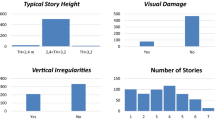Abstract
This paper is proposing an machine learning based expert system for preliminary prediction of the insulation fire resisting performance of shallow floor systems when subject to exposure to the ISO 834 Standard Fire Curve. The proposed system is a digital tool which incorporates a machine learning algorithm trained on the outcomes of pre-run two-dimensional finite element heat transfer analyses of shallow floor system details. The algorithm predicts the insulation performance of similar details with a measurable accuracy of 96% (i.e the insulation rating band was predicted correctly in 96% of the cases) without the requirement for an explicit deterministic analysis. The paper presents the challenges and prerequisites to build such an expert system and acts as a proof of concept for the use of machine learning for the assessment of the insulation performance of shallow floor system under the guidance of BS EN 1363-1:2012. A Support Vector Machine machine learning algorithm is adopted in this work. The required processes that were needed for the development of the expert system include the stages of data acquisition, exploratory data analysis, choice of machine learning algorithm, model training, tuning, and validation. This expert system is useful for practitioners to rapidly assess the feasibility of different construction details at early stages of the design process.


reproduced from Cengel, Yunus A. (2007) [19])









reproduced from Pedregosa et al (2011) [22])








Similar content being viewed by others
References
Flint G, Lamont S, Lane B, Sarrazin H, Lim L, Rini D, Roben C (2013) Recent lessons learned in structural fire engineering for composite steel structures. Fire technol 49(3):767–792
Usmani AS, Rotter JM, Lamont S, Sanad AM, Gillie M (2001) Fundamental principles of structural behaviour under thermal effects. Fire Safety J 36(8):721–744
Newman GM (1995) Fire resistance of slim floor beams. J Constr Steel Res 33(1–2):87–100
Bailey CG (1999) The behaviour of asymmetric slim floor steel beams in fire. J Constr Steel Res 50(3):235–257
Mäkeläinen P, Ma Z (2000) Fire resistance of composite slim floor beams. J constr steel res 54(3):345–363
Maraveas C, Swailes T, Wang Y (2012) A detailed methodology for the finite element analysis of asymmetric slim floor beams in fire. Steel Constr 5(3):191–198
Maraveas C, Tsavdaridis KD, Nadjai A (2017) Fire resistance of unprotected ultra shallow floor beams (USFB): a numerical investigation. Fire technol 53(2):609–627
Naser MZ (2018) Deriving temperature-dependent material models for structural steel through artificial intelligence. Constr Build Mater 191:56–68
Naser MZ (2019) Fire resistance evaluation through artificial intelligence-A case for timber structures. Fire safety J 105:1–18
Naser MZ (2020) Autonomous fire resistance evaluation. J Struct Eng 146(6):04020103
Cai B, Xu LF, Fu F (2019) Shear resistance prediction of post-fire reinforced concrete beams using artificial neural network. Int J Concrete Struct Mater 13(1):46
Lazarevska M, Gavriloska AT, Laban M, Knezevic M, Cvetkovska M (2018) Determination of fire resistance of eccentrically loaded reinforced concrete columns using fuzzy neural networks. Complexity. https://doi.org/10.1155/2018/8204568
Ryu E, Kang J, Lee J, Shin Y, Kim H (2020) Automated detection of surface cracks and numerical correlation with thermal-structural behaviors of fire damaged concrete beams. Int J Concrete Struct Mater 14:1–12
Liu JC, Zhang Z (2020) Neural network models to predict explosive spalling of PP fiber reinforced concrete under heating. J Build Eng. https://doi.org/10.1016/j.jobe.2020.101472
Al-Jabri SK, Al-Alawi MS (2007) Predicting the behaviour of semi-rigid joints in fire using an artificial neural network. Steel Struct 7:209–217
Daryan SA, Yahyai M (2018) Predicting the behaviour of welded angle connections in fire using artificial neural network. J Struct Fire Eng 9(1):28–52
Feng F (2020) Fire induced progressive collapse potential assessment of steel framed buildings using machine learning. J Constr Steel Res 166:105918
Salehi H, Burgueno R (2018) Emerging artificial intelligence methods in structural engineering. Eng Struct 171:170–189
Cengel, Yunus A. (2007). Heat and mass transfer: a practical approach (3rd edition ed.). McGraw Hill. pp. 231–236. ISBN 978-0-07-312930-3.
Ng, A. (2017) Coursera Online Course: Machine Learning. University of Stanford. Available at: https://www.coursera.org/learn/machine-learning/home/welcome
Cevik A, Kurtoglu A, Bilgehan M, Gulsan EM, Albegmprli MH (2014) Support vector machines in structural engineering: a review. J Civil Eng Manag 21(3):261–281
Pedregosa et al (2011) Scikit-learn: machine learning in python. JMLR 12:2825–2830
Platt John (2000) Probabilistic Outputs for Support Vector Machines and Comparisons to Regularized Likelihood Methods. Adv, Large Margin Classif, p 10
Author information
Authors and Affiliations
Corresponding author
Additional information
Publisher's Note
Springer Nature remains neutral with regard to jurisdictional claims in published maps and institutional affiliations.
Rights and permissions
About this article
Cite this article
Panev, Y., Kotsovinos, P., Deeny, S. et al. The Use of Machine Learning for the Prediction of fire Resistance of Composite Shallow Floor Systems. Fire Technol 57, 3079–3100 (2021). https://doi.org/10.1007/s10694-021-01108-y
Received:
Accepted:
Published:
Issue Date:
DOI: https://doi.org/10.1007/s10694-021-01108-y




